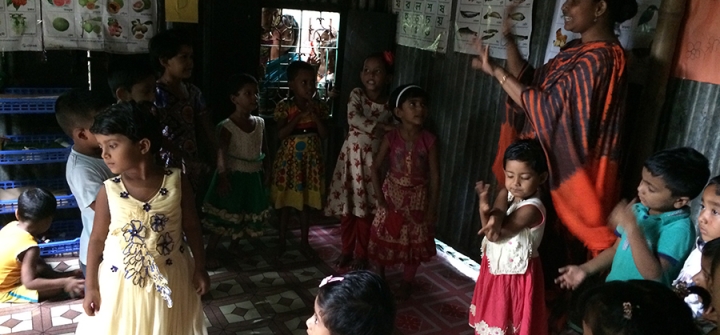The Last Temptation of a Child: Drowning Prevention in Rural Bangladesh
The few photos I have seen in newspaper clippings are remarkably similar: Small children with wet faces; their heads cranked back and their lifeless mouths open like dead fish. In one video, a young father tightens his face as he struggles to hold back his tears. The testimony of his own child’s death leaves him incredulous. And yet the stories repeat themselves. In village after village in rural Bangladesh, more children die from drowning during playtime than any other way.
Last fall, I traveled to Matlab district in Bangladesh to investigate drowning-related deaths among children. I was part of a team from the Johns Hopkins International Injury Research Unit building real-time prevention and surveillance mechanisms to prevent these deaths—part of a drowning project funded by Bloomberg Philanthropies.
“I hope the amount of water won’t be a shock to you,” said my local colleagues from the Center of Injury Prevention and Research, Bangladesh and International Center for Diarrheal Disease Research, Bangladesh. When we finally reached the field site—a 7-hour commute from the capital, Dhaka—the challenge loomed obvious. Large stagnant natural reservoirs of water, 2-10 feet deep, nestle between the forests and homes and straddle the paths. Getting to the child-safe centers (called anchals) we were helping build involved navigating slippery levees or walking on unstable bamboo bridges above these pools.
I am an adult, from a landlocked country, and do not know how to swim. I had one close encounter with death from drowning as a child, and my body and mind carry deeply internalized memories of water flooding my lungs, painful spasms in my larynx, involuntary muscle reflexes, and the eventual blackout before being revived. My colleagues sensed my hesitation and offered to guide me across a muddy thread of land.
The figures from Bangladesh are mind-boggling, with drowning-related deaths averaging almost 10 times higher than the US. But in villages like Matlab, that number rises to higher than a 15x multiplier. There are at least a dozen other villages like Matlab with an equal or worse track record on drowning deaths among children. This isn’t a statistical anomaly.
In Matlab, I felt like I was chasing ghosts. Locals have a lexicon of supernatural beings and omens that explain how and why children drown. The water, according to some, produces a counterintuitive effect—creating intense fear on one hand, and generating an allure and impulse to dive in on the other. Widespread superstition, combined with the lack of regulation in rural areas, only creates a deadly feedback loop.
When I arrived, the toll of child deaths due to drowning was not immediately obvious. The air hung heavy in the aftermath of monsoon rains, and the sounds of children playing contrasted starkly to the epidemic of despair that I was expecting. During the day, when adults were busy at home or in the fields, children often plied these pools—drawn by the prospects of cooling off, exploring the unknown, or simply playing.
Over the last 6 years, our collaboration (JH-IIRU, CIPRB and ICDDRB) has been trying to solve the problem by introducing safety measures like playpens and crèches (anchals). The approach is based on the scientific principle that in order to keep children away from the water, barriers must be placed between the risk and the child. Children under 5 years of age attend these anchals during the early hours of the day and are supervised by volunteer mothers and community assistants in a number of play-oriented activities. The activities have dual purpose—protect young, naturally curious and exploring minds from the water, and develop their social and cognitive skills.
In Matlab, the crèches—raised bamboo sheds in some places, donated cemented rooms in others—seem to be working. Families have come together to cooperate and volunteer their homes. Drowning deaths have reduced significantly; Matlab has not recorded a single such casualty among children in crèches over the last 2 years. Additionally, parents suffer less anxiety over their children’s safety.
Approximately 50,000 children are enrolled in more than 2,500 crèches across 7 sub-districts of rural Bangladesh, but our work seems endless. When I was leaving Matlab, I noticed the sky graying from looming rain clouds. And the first set of kids was already out playing in the pools outside their homes.
Priyanka Agrawal, MScD, MPH, is a post-doctoral fellow at the Johns Hopkins International Injury Research Unit, Johns Hopkins Bloomberg School of Public Health.
Join the tens of thousands of subscribers in more than 100 countries who rely on Global Health NOW summaries and exclusive articles for the latest public health news. Sign up for our free weekday enewsletter, and please share the link with friends and colleagues: http://www.globalhealthnow.org/subscribe.html
A day in an anchal: Children sing and dance to a Bangla rhyme along with their crèche mother. Image by Priyanka Agrawal.




